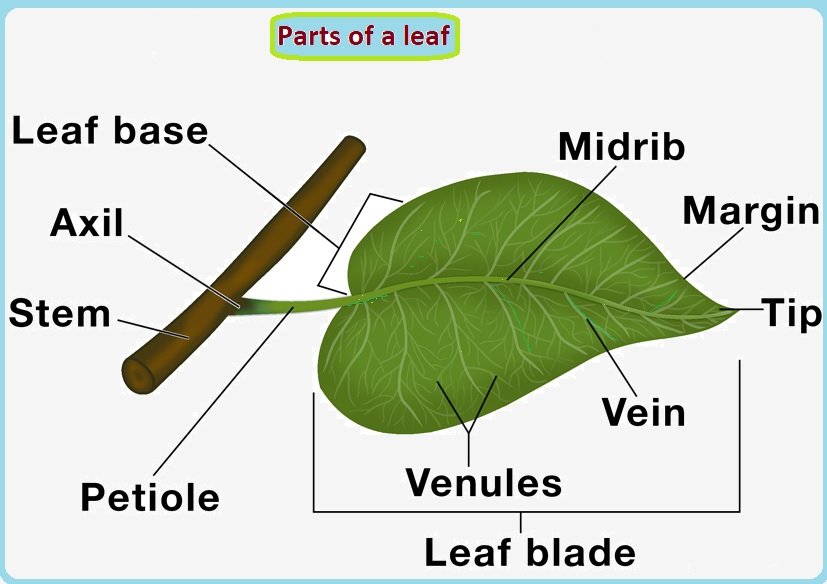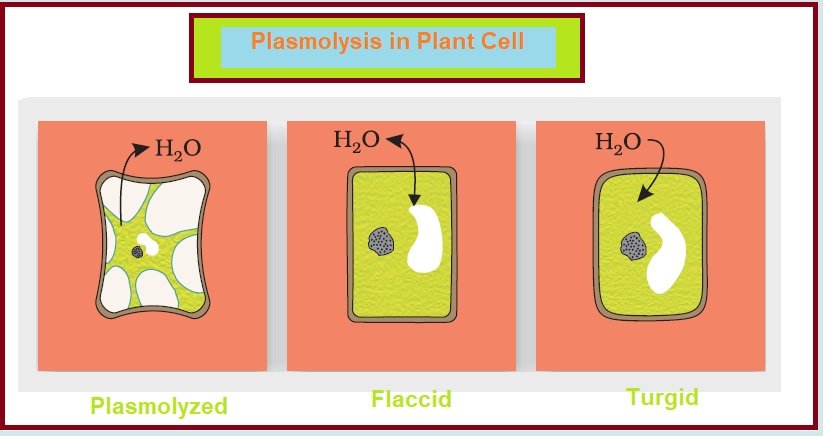Morphology of Leaf
Introduction: Leaf
A leaf (plural leaves) can be defined as a dorsoventrally flattened structure that arises from the node of the stem and bears a bud in its axil. The axillary bud later develops into a branch. They develop from shoot apical meristem and are arranged in an acropetal order.
Leaves consist of upper (adaxial) and lower abaxial surfaces that differ in color, hairiness, number of Stomata (the stomata are pores that intake and output gasses), and other features.
Leaves are also called the kitchen of plants. These are the most important organs of most vascular plants. The leaves are mostly green due to the presence of chlorophyll. The green plants are autotrophic, they do not get food from other living things.
- Leaves create their food by photosynthesis.
- Chlorophyll is essential for photosynthesis as it absorbs light energy from the sun. So the leaves are the main organ responsible for photosynthesis.
- The leaves capture the energy from sunlight and they use it to make simple sugars, such as glucose and sucrose, from carbon dioxide and water. They store sugars as starch.
Parts of leaves
A leaf contains mainly three parts: leaf base, petiole, and lamina.
Leaf base (Hypopodium):
The leaf base is the basal part of the leaf by which the leaf gets attached to the stem.
- In monocotyledons, the leaf base expands into a sheath covering the stem partially or wholly.
- In some leguminous plants, the leaf base may become swollen, which is called the pulvinus.
- Stipule: In many species of plants the leaf may bear two lateral small leaf-like structures called stipules.
Petiole (Mesopodium):
Petiole is a stalk-like structure in leaves. The petiole helps hold the blade to light. The petioles are Long thin and flexible allowing leaf blades to flutter in the wind, thereby cooling the leaf and bringing fresh air to the leaf surface.
Lamina ( epipodium):
Lamina is also called the leaf blade. it is the green expanded part of the leaf having veins and veinlets.
- There is, usually, a middle prominent vein, which is known as the midrib.
- Veins provide rigidity to the leaf blade and act as channels of transport for water, minerals, and food materials. The shape, margin, apex, surface, and extent of incision of lamina vary in different leaves.

Venation in Leaves
Venation can be defined as the arrangement of veins and the veinlets in the lamina of the leaf. Different type of plants shows different types of venation.
- Reticulate venation- When the veinlets form a network, the venation is termed reticulate. Leaves of dicotyledonous plants generally possess reticulate venation. Ex. Rose plant
- Parallel Venation: When the veins run parallel to each other within a lamina, the venation is termed parallel. Parallel venation is characteristic of most monocotyledons. Ex. Paddy

Types of Leaves
Leaves are divided into two main categories as simple and compound leaves and are further divided into different groups based on their structure, shape, size, arrangement, etc.
Simple leaf:
A leaf is said to be simple, when its lamina is entire or when incised, the incisions do not touch the midrib. ex. Guava
Compound leaf:
When the incisions of the lamina reach up to the midrib breaking it into a number of leaflets, and connected by a single petiole, the leaf is called a compound. e.g., Peas, Palm leaves. The compound leaves are further divided into two types:

Pinnately compound leaf:
A number of leaflets are present on a common axis, the rachis, which represents the midrib of the leaf as in neem. Pinnately compound leaves are divided into the following groups:
- Unipinnate: Having only one leaflet. Ex. Cassia
- Bipinnate: In this type, a secondary axis is found with a leaflet that emerged from a central axis. Ex. Acacia.
- Tripinnate: the tertiary axis having leaflets that emerge from the secondary axis. EX. Moringa
- Decompound: The leaf consists of more than three pinnate. Ex. The old leaves of coriander.
- Paripinnate: The leaf is without a terminal leaflet Ex. Cassia
- Imparipinate: The leaf has an odd terminal leaflet. Ex. Pea.
Palmately compound leaf:
In this type of compound leaves, the leaflets are attached at a common point, i.e. at the tip of the petiole, as in silk cotton. Palmately compound leaf can be further differentiated as:
- Unifoliate: consisting of only one leaflet. e.g. Citrus
- Bifoliate: The leaves consisting two leaflets. e.g. Balanties.
- Trifoliate: The leaves consist of three leaflets that are emerging from the same point. e.g. Oxalis
- Quadrifoliate: The leaves with four leaflets arising from the same point. e.g. Marsilea
- Multifoliate: Many leaflets arise at a common point. e.g. Bombax.
Phyllotaxy
The pattern of arrangement of leaves on the stem or branch is called the Phyllotaxy. These patterns are of three types:
- Alternate: In this type of phyllotaxy, a single leaf arises at each node in an alternate manner, for example, in china rose (Hibiscus rosa sinesis), mustard (Brassica campestris), and sunflower (Helianthus annuus) plants.
- Opposite: In the opposite type, a pair of leaves arise at each node which lies opposite to each other. Ex. as in Calotropis and guava ( Psidium guajava ) plants.
- Whorled: when more than two leaves arise at a node that forms a whorl of leaves, called whorled phyllotaxy. Ex, Alstonia (Alstonia scholars).

Modification of Leaves
The leaves often modify to perform functions other than photosynthesis. In the given table we are discussing various modifications of leaves.

Table of Modification of Leaves
Leaves modify to perform various functions, these are listed in the table below:
| Modification of Leaves | ||
| Modification | Form | Example |
| Tendril | These are green threadlike, thigmotrophic, do not have scale leaves, are unbranched, and climb to support the weak stem | |
| Whole leaf tendril | In this type entire leaf is modified into a tendril | Wild pea (Lathyrus aphaca) |
| Leaflet tendril | The upper part is modified into a tendril only | Pisum sativum and Bignonia venusta |
| Stipular tendril | The stipules modifies into tendril | Smilax |
| Petiolar tendril | Petiole modified into a tendril | Clematis and Nepenthes |
| Leaf apex tendril | Thegmotropic leaf apex modifies into a tendril | Gloriosa |
| Spine | The whole leaf or part of the leaf modifies in the form of spines. Functions for protection, transpiration, etc. | Opuntia (whole leaf-spine)
Argemone (margin) And Acacia (stipules) |
| Succulent | The leaves become fleshy due to the storage of food material or water. | Aloe, Bryophyllum |
| Insect catching | The leaves modify to catch insects and absorb their Nitrogen for plants’ requirements. | |
| Pitcher plant
The lamina forms the pitcher |
The lamina of leaves modifies into a pitcher to catch and digest the insects. | Nepenthes and sarracenia |
| Bladder | The leaf form bladder to trap insects | Utricularia |
| Some other modifications of leaves | ||
| Phyllode | Flat, petiole green, and photosynthetic | Acacia and Parkinsonia |
| Hooks | Terminal leaflet modifies claw-like | Bigonia and Asparagus |
| Reproductive | Adventitious buds | Bryophyllum, Salvinia |
| Heterophylly | More than one type of leaves found on the same plant | Casuarina |
| Leaf scales | Leaf modifies in sessile, thin, and membranous form. | Balanophora, Orobanche |
Functions of Leaves
Leaves perform several functions:
- Photosynthesis- is the primary function of leaves. In this process, they convert carbon dioxide, water, and sunlight into glucose.
- Transpiration- the process of removal of excess water from the plants into the atmosphere. it occurs through the opening of stomata in the leaves.
- Guttation- Removal of Excess water from the xylem can be seen at the edge of the leaves when the stomata are closed.
- Defense- some of the leaves modify in the form of spines for defense. Ex. Opuntia
- storage- the leaves’ main function is photosynthesis, so they store water and nutrients, some get modified also for the function of storage of food or water storage.
You can also read:
- Morphology of stem
- root system (morphology of root)
- Biological classification
- Plant kingdom – The Algae
- Bryophytes
- Pteridophytes
- Gymnosperms
- Angiosperms
Refferences: https://en.wikipedia.org/wiki/Plant_morphology
Thank you






[…] Morphology of leaf […]
[…] Morphology of leaf […]
[…] Morphology of leaf […]
[…] Morphology of leaf […]
[…] Morphology of leaf […]
[…] Morphology of Leaf […]
[…] Morphology of leaf […]
[…] Morphology of leaf […]